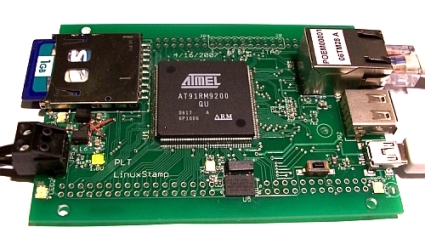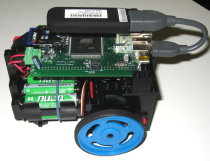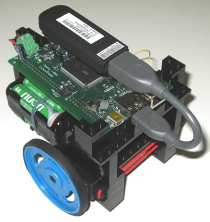Tiny, 6-chip open computer runs Linux
Last updated Aug 6, 2008 — 42806 views Embedded designer Paul Thomas is showcasing a tiny, open-sourced computer at LinuxWorld in San Francisco this week. Would-be “Linuxstamp” enthusiasts can obtain pre-built boards for the hefty sum of $120 directly from Thomas, or they can download the design for free and build it themselves.
Embedded designer Paul Thomas is showcasing a tiny, open-sourced computer at LinuxWorld in San Francisco this week. Would-be “Linuxstamp” enthusiasts can obtain pre-built boards for the hefty sum of $120 directly from Thomas, or they can download the design for free and build it themselves.
This post has been relocated to LinuxGizmos.com. Please click here if you are not redirected automatically.
The Linuxstamp is an extremely simple hardware design, consisting of six integrated circuits (processor, flash, RAM, serial-to-USB, ethernet PHY, and power conversion) plus a bunch of passives.

The Linuxstamp is built from just six ICs
(Click to enlarge)
Thomas demonstrated the Linuxstamp in the “Garage” area of Linuxworld. The most eye-catching of his demos was a home-made robotic car, constructed with legos and moved around by a couple of wheels controlled by the Linuxstamp (see photos below). In this demo, the Linuxstamp operated untethered, thanks to wireless capability supplied by a USB/WiFi adapter plugged into the board’s USB host port.


Wireless Linuxstamp-powered robot demo at LinuxWorld
(Click each image to enlarge)
The hardware
Despite its simplicity, the Linuxstamp’s features include:
- Atmel AT91RM9200 processor (ARM9 core, includes MMU)
- 32MB SDRAM
- 8MB SPI flash memory
- 10/100 Ethernet (supplied by the Atmel processor)
- USB host port (supplied by the Atmel processor)
- USB device port (generated by a serial/USB converter)
- SD card slot
- USB debug port (via the USB device port)
- JTAG port
- Can be powered via POE
The board’s processor, a 180 MHz Atmel AT91RM9200 system-on-chip, integrates an ARM9 CPU core (with MMU) along with controllers for USB host and device ports, 10/100 Ethernet, MMC/SD card interface, sync/async serial ports, SPI (serial peripheral interface), and more.
Thomas was careful to keep the Linuxstamp’s design simple enough to allow for a two-layer PCB design, which minimizes costs and simplifies homebrew construction.
Another example of keeping things simple is the inclusion of a USB-based serial debug port, implemented via a serial/USB converter chip. Thanks to this feature, users of the board most likely won’t need to use the board’s JTAG debug port, according to Thomas.
Even initialization of the board’s low-level bootstrap loader is easy, Thomas adds, since the Atmel processor includes an innovative, built-in hardware bootstrap function that automatically attempts to load the onboard SPI flash via the serial debug port when a newly built board powers up for the first time.
Bootstrap loaders and Linux OS
Thomas notes that there are two levels of bootstrap loader: a tiny loader provided by Atmel initializes the processor and its interfaces, and then loads U-boot, which does the rest. This process is described in detail on the Linuxstamp’s wiki site.
As its name implies, the Linuxstamp runs Linux. At least two distributions are currently available: a minimal filesystem that boots and runs entirely from within the Linuxstamp’s 8MB flash and 32MB RAM memory; and a more complete, debian-based filesystem that requires an SD card to supplement the board’s on-board flash. In addition to the linux kernel, the minimal filesystem includes BusyBox and DropBear SSH (a small SSH client/server), among other basic system functions. The minimal system system allocates about 2MB of the 8MB available flash to linux and the boot-loaders, with the rest for the filesystem, according to Thomas.
Both OSes are based on kernel sources obtained from kernel.org and compiled specifically for the board’s hardware, Thomas says. The filesystem images, a cross compiler, bootstrap loader images, and sources are available from the Linuxstamp’s ftp site.
Availability
To purchase a ready-made Linuxstamp (priced at $120 plus shipping, as of this writing), visit TheLinuxStamp.com. For more technical details on the Linuxstamp and to obtain its “open source” design (it’s released under the GNU GPLv2), visit the Linuxstamp’s wiki.

Also of interest is the beagleboard (http://beagleboard.org) which is $149 and includes a somewhat beefier processor. However, you would have trouble making it yourself..
This is great news. It is no wonder that ARM is in everything! The iPhone has 2!
The beagleboard is interesting, but doesn’t have Ethernet. And if you don’t need a full-blown LCD screen, this is definitely the way to go.
$120 is hardly a “hefty sum”. I saw Paul later with his wife and child, so I think it goes to a good cause :).
Love it, think I’ll get one. I haven’t found yet where the amount of i/o gets discussed. Analog and digital i/o count is of interest to me but can’t find it covered.
@yonnie:
The datasheet of the AT91RM9200 can be found here:
http://atmel.com/dyn/resources/prod_documents/1768s.pdf
Is there a port of a real-time operating system to this board?
How well does ntpd work on this board? How stable is the clock?
“Andrew Shuttlewood Says:
August 7th, 2008 at 4:09 am
Also of interest is the beagleboard (http://beagleboard.org) which is $149 and includes a somewhat beefier processor. However, you would have trouble making it yourself..”
you cant be serious, for an extra $50 you can get a fully made developer dualcore 400Mhz Genesi development board of a MPC5123 PPC system reference design.
http://www.genesi-usa.com/press.php?date=20080414
http://media.freescale.com/phoenix.zhtml?c=196520&p=irol-newsArticle&ID=1128581&highlight=
“Freescale dual-core processor simplifies embedded Linux® OS-based design
Power Architecture™ processor, backed by mobileGT® Linux starter kit, designed to reduce cost and time-to-market for industrial applications ”
“The MPC5123, a next-generation successor to the popular MPC5200 processor, combines a Power Architecture e300 core scaling to 400 MHz with an advanced multimedia co-processor to deliver exceptional processor performance. ”
“mobileGT® starter kit with Linux OS
The MPC5123 processor is supported by a cost-effective starter kit that includes a Linux® OS board support package (BSP) optimized for the MPC5123 processor. Freescale’s mobileGT Linux software includes fully functional Linux open-source images with source code, an open-source tool chain and design documentation. The software was developed in collaboration with Genesi, a leading provider of open-source platforms for the 32-bit embedded market.
“Freescale’s motherboard-on-a-chip will help redefine the 32-bit embedded market and establish new market standards for open client network computers,” said Bill Buck, general manager of Genesi U.S.A, Inc. “Our collaboration with Freescale around the MPC5123 device benefits the growing open-source development community by providing a powerful, cost-effective processing platform for embedded systems based on Power Architecture technology.”
The MPC5123 processor platform is backed by a growing ecosystem of development tool, middleware and real-time operating system (RTOS vendors).
MPC5123 product features
e300 core
Built on Power Architecture technology
32KB instruction cache and 32KB data cache
Double-precision floating point unit and dual integer units
Up to 400 MHz performance, delivering 800 MIPS
User-programmable 32-bit RISC multimedia core operating at up to 200 MHz
Integrated display controller supporting up to 720p (1280×720) and WXGA (1366×768) resolution
12 programmable serial controllers supporting UART, SPI, AC97, I2S
SDRAM DDR-I/DDR-II/mobileDDR memory controller
10/100 Fast Ethernet media access controller (MAC)
Three I2Cs
PCI 2.3 interface
Dual USB 2.0 On-the-Go (OTG) controller with an integrated high-speed PHY
Serial advanced technology attachment (SATA) controller
Parallel advanced technology attachment (PATA) controller
Four CAN 2.0A/B modules
64-channel intelligent DMA I/O controller
Sony/Phillips digital interface format (S/PDIF) serial audio interface
Secure digital host controller (SDHC) supporting MMC/SD/SDIO protocols
27×27 mm – 1 mm pitch 516-pin PBGA package
Pricing and availability
Samples of the MPC5123 processor are planned to be available in late third quarter 2008. Suggested resale pricing for the MPC5123 in 10,000-unit quantities starts at $20.00 (USD). Development kits bundled with the MPC5123 processor are planned to be available for a suggested resale price of $199 (USD).”
and the last Genesi Efika retail board (4watts total while _working_[NOT idol or in low power standby mode] with PCI gfx card installed)that came from their last developer board come in at $99 USD ,so expect any new retail board to come in well below that current %199 developer board in time….
sure the the ARM920T™ ARM® Thumb® Processor – 200 MIPS at 180 MHz,can beat the PPC on power while also working, but the expected 4watts total/average useage expected again from MPC5123, is well within the battery+ PV and/or fuelcell gives you a far greater expectation for gettign real work done.
an addition of an onboard 11n reprogramable wireless and gigE chipset might make this an even better fit for any home video IP streaming base OC…. 😉
I don’t think 60 pounds is unreasonable – manufacture in small volumes, especially surface mount, is not easy or cheap. I think the product looks very interesting, and can thinks of lots of uses. I can’t see why the price is seen as ‘hefty’.
true, for a one man project its a nice thing, as yu mention 60 pounds i assume you mean UKP as in twice the $ per £ ?, alas it doesnt work out that way, buy the time you have added UK VAT and shipping its virtually the same price but in UKP I.e £120+, as is buying the parts from maplins/farnel etc locally… dont you just love the Uk and EU price tariffs (NOT ;( )
its a shame he cant get his hands on single small batch that dual MPC5123 PPC computer on a chip to use for his next project though, or even better perhaps, the newest Built on Power Architecture™ Technology
MPC8610 Integrated host processor
perhaps he can get one donated in the
http://www.freescale.com/files/32bit/doc/fact_sheet/MPC8610FS.pdf?fsrch=1
and a copy of the latest freevec libray
http://www.freevec.org/functions
http://www.freescale.com/webapp/search/Serp.jsp?fsrch=1&isAdvanceSearch=false&showCustomCollateral=false&RELEVANCE=true&fromTrng=false&showAllCategories=false&fromPSP=false&pageNum=1&assetLocked=false&assetLockedForNavigation=false&fromDAP=false&fromWebPages=false&pageSize=25&isComparison=false&
re: “hefty sum of $120″…
Sorry about my use of irony! What I meant to imply with that wording was that the board’s $120 price is quite low for what you’re getting. IIRC, the wiki lists the raw parts cost as $75 in small volumes — and that doesn’t include assembly and test labor, amortization of the developer’s engineering time, etc. In short: it’s a GREAT deal! 🙂
While it is interesting, it’s hardly the first or smallest of its kind…
uCSimm was first of course (but m68k).
I also became aware of Armadeus recently:
http://www.armadeus.org/
That’s an awesome looking product. I just built an ITX Atom server, and I thought it was small. *GrinZ* Is there a version that comes with the Lego chassis? 😛
This is a good product and the board looks nice layouted, nice job.
A friend of mine has made this board: http://labs.ti.bfh.ch/gecko/
Anybody willing to share their saved copy of the project files of the LinuxStamp? the ftp site is not working… Please post a link .. Thanks.
How about if everybody lists their applications of this great little toy?
I would like to see whether people just play with it, or use it do something cool, maybe even useful 🙂
This category of boards gets increasingly popular – another one is the foxboard (http://www.acmesystems.it/?id=4), with less computing performance and more aimed at embedded control, but also in the same general price range as the linuxstamp and the beagleboard.
The MPC5123 board pip mentioned can not be bought yet – we will see if the suggested price holds and 199$ are still 30% more than 149$ and 60% more than 120$. While all running linux and similar in size and power consumption, they are quite different in performance, interface details and therefore target applications (multimedia, embedded control, slim desktops).